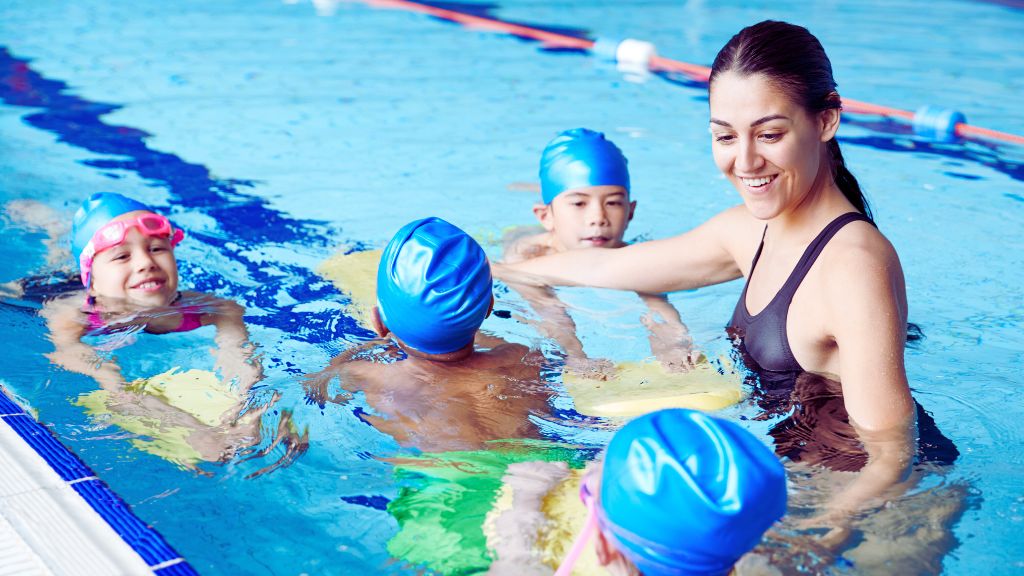Table of Contents
How Can Caregivers Help Children with Autism Stay Safe During the Summer Season?
National Water Safety Month is a vital time to foster awareness about water safety, which is critical, especially for children with autism spectrum disorder (ASD). Unfortunately, statistics reveal alarming risks related to water for the autism population.
The American Red Cross describes children on the ASD spectrum as roughly 160 times more likely to drown than children without ASD.
As a result, many families ask: How can caregivers help children with autism stay safe during the summer season? Also, how does the National Water Safety Month help?
The answer lies in education, prevention, and creating a safe and inclusive environment for people with ASD to enjoy the benefits of water activities safely.
This blog by ABA Centers of Pennsylvania will discuss the importance of water safety for individuals with autism and explore how National Water Safety Month can help foster greater awareness and prevent water-related accidents.
Finally, we will discuss how ABA therapy can support many people with autism by teaching them essential safety skills related to water activities.
So, please keep reading to learn more about this trending topic!
Visit us here to discover more about ABA Centers of Pennsylvania and what distinguishes our approach to ABA care. Click here to read other blogs about ABA therapy, autism, and neurodiversity.
Why National Water Safety Month Is Critical for Children with Autism
According to the National Autism Association, accidental drowning has been responsible for over 70% of deaths in children with autism aged 14 and younger in recent years.
This alarming statistic highlights that National Water Safety Month is not just an awareness campaign; it can genuinely save lives.
There are several reasons why youth with autism often encounter specific challenges in water-related environments. These include, but are not limited to:
- Elopement (Wandering Behavior): Many children on the autism spectrum are attracted to open water, which can lead to dangerous situations if they wander away from their caregiver.
- Sensory Sensitivities: Water can create overwhelming sensory experiences, from its texture to the sounds of splashing. These features can make it difficult for some with ASD to process safety instructions.
- Difficulty Recognizing Danger: Many children with autism may not naturally perceive water as a hazard, which makes close supervision vital.
Recognizing these water-related difficulties emphasizes the importance of incorporating tailored drowning prevention measures into daily life.
7 Water Safety Strategies for Children with Autism
Here are actionable tips families should implement to enhance water safety for children on the spectrum this summer and all year long.
1. Instill Clear Water Safety Rules
Create clear and consistent rules about water safety, such as never approaching water without an adult or always wearing a life jacket.
Encourage your child to use visual aids or social stories to make these concepts engaging and easy to grasp. Caregivers should also regularly reinforce these rules to help children internalize and apply them.
2. Start with Swim Lessons
Enrolling your neurodiverse child in specialized swim lessons is one of the most effective ways to reduce drowning risks.
Some swim instructors hold specializations in neurodiversity to help support children with autism by being flexible, patient, and utilizing adaptive techniques.
Teaching key skills, such as floating, treading water, and safely exiting a pool, is also critical for safe swimming.
3. Supervise with a Water Watcher
Assign one adult to act as the designated “Water Watcher.” This person should focus solely on supervising the child on the ASD spectrum whenever the child is near water.
This watcher should avoid distractions like phones and multitasking during this role.
4. Provide Barriers and Safety Equipment
Install secure barriers, such as four-sided pool fences with self-latching gates, around any water areas at home.
Additionally, it’s always important to equip your child with a properly fitted, U.S. Coast Guard-approved life jacket when swimming or near open water.
5. Keep Water Safety Fun
Make water safety practice fun with activities like teaching your child to float on their back, reach for their favorite-colored pool noodles, or use a soft flotation device.
Building muscle memory for emergencies is critical in boosting your child’s confidence and safety around water.
6. Develop Personalized Water Safety Plans
It is key to have a structured water safety plan tailored to your family. This plan should include elements like reciting emergency contact information and risk-specific guidelines for outings near water.
It’s always a good idea to anticipate scenarios in advance to stay prepared. You can also opt for wearable tracking devices, especially designed for neurodivergent children, to locate your child if they wander into water areas quickly.
7. Engage and Educate First Responders
Inform local first responders, such as police or lifeguards, about your child’s specific needs, triggers, or communication preferences. Many communities have programs to connect families with emergency services for individuals with autism.
The Role of ABA Therapy in Water Safety Education
Applied Behavior Analysis (ABA) therapy can significantly help teach vital water safety skills.
Through ABA, children with autism can learn behaviors such as following safety instructions, interpreting warnings, and responding to emergencies appropriately.
ABA techniques, such as positive reinforcement and errorless learning, can help children build these critical life skills at their own pace.
Celebrate National Water Safety Month with Knowledge and Action!
National Water Safety Month reminds us of the importance of proactive measures to safeguard children, especially those with autism, around water.
Fortunately, with the proper preparation, resources, and support, families can reduce risks and enjoy water activities together with peace of mind.
So, keep learning ways to keep your child safe this summer and all year long.
If you’re interested in equipping your child with water safety knowledge year-round, consider connecting with ABA Centers of Pennsylvania for ABA care that offers many new opportunities for developmental expansion.
Safer Summers with the Support of ABA Centers of Pennsylvania
At ABA Centers of Pennsylvania, we recognize the vital importance of creating a safe and enjoyable environment for youth with autism during the summer months.
Our dedicated ABA team is committed to providing resources, guidance, and tailored ABA support to ensure that every neurodivergent child can experience the joys of water activities without compromising their safety.
Visit ABA Centers of Pennsylvania or contact us today to learn more about ABA programs and options for ASD diagnostic support. Call us at (844) 444-7496 or visit this online link.
Together, we can cultivate a safe and enriching environment, allowing children to enjoy water activities while keeping their well-being at the forefront.








